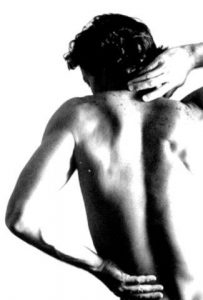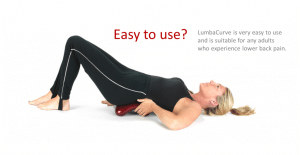

Usually, back pain sufferers recover completely, by avoiding further strain to their lower back. Initial back treatment often comprises the application of heat and cold back pain therapy, or medication. If the back pain continues for more than a few days then it’s wise to see your GP to seek advice on an effective back pain therapy regime and ensure that there are not more serious (although infrequent) underlying reasons for the back problem which could include:-
- Degenerative disc disease – where the discs in the spine gradually wear down
- A fracture – maybe as the result of a fall or injury
- Osteoarthritis – a wear-and-tear disease that can affect the spinal joints
- Osteoporosis – where the bones lose density causing them to become weak, brittle and more likely to break
- Rheumatoid arthritis – an inflammatory condition of the immune system leading to inflammation of joint linings and surrounding structures
- Slipped disc – where a disc bulges to the point that it exerts pressure on the spinal nerves
- Spinal stenosis – a condition where the spaces in the spine narrow restricting the nerves
- Spondylolithesis – where one of the spinal bones slips out of position
Research has indicated that although some types of low back pain may be partly due to genetics (i.e a tendency to develop lower back pain or lumbar pain could be inherited from parents), it is often generally sparked off or aggravated by the following factors:-
Driving for long periods
What’s happening here is not dissimilar to posture related conditions. Quite often it’s a combination of adopting a ‘slouch’ behind the wheel where the spine is not in a natural ‘at rest’ position. Instead the lumbar region is being subjected to contortion and constricted movement, which can cause increased uneven pressures in the vertebral joints, and stress and tension in the surrounding muscles and ligaments. This can lead to lower back pain in drivers after long periods behind the wheel. In addition to this the driver is being subjected to ‘whole body vibration’ which occurs when the body is in contact with a surface that is oscillating e.g. car wheels over an uneven road surface or the vibrations from the vehicle engine. These vibrations are transferred through the body to the spine and soft tissues which in turn can cause damage and back pain. (Source: Magnusson ML, Pope MH, Wilder DG, Areskoug B. Are occupational drivers at an increased risk for developing musculoskeletal spine disorders?)
Lifting heavy objects
Applying unbalanced or excessively heavy loads on the spine can lead to back problems, either as an acute (short term) lower back pain or maybe potentially leading to chronic (long term) conditions in the future. Alternatively it might be caused by repetitively lifting lighter objects as part of our occupation. We all know the rules around the workplace. “Lift close to your body, keep the back and hips straight, bend the knees to lower the ground” etc but often we don’t apply these rules to get the job done and it’s only when the back pain kicks in do we sometimes revert to common sense application of the rules. It’s important to be aware of the consequences
Poor posture
This might be caused by a number of factors such your ‘normal’seated position in the workplace. These could include a poorly ergonomically designed pc workstation, or poorly designed work layout around a process. Initially this could cause stiffness in the facet joints of the lumbar region (These are the ‘flat’ plate like joints connecting the vertebrae.), with the surrounding muscles, overworking to stabilise this becoming irritated and inflamed thereby causing lower back or lumbar pain or sciatica Over prolonged periods poor postural position may also cause your vertebrae to apply uneven pressure on the discs in between possibly leading to a bulging disc or herniated disc, which again would cause long term lower back pain and discomfort for the sufferer
Standing for long periods
It’s estimated that an adult can be up to half an inch shorter in the evening than in the morning. That’s because whilst a person is standing or upright throughout the day then gravity is constantly causing downwards pressure on the joints of the lower back and eventually this could lead to lower back pain or discomfort. It may be useful to do occasional stretches, or try to move around if you can, or sit down at opportune moments
Stress
There is an association between stress and back pain. Under stress, there is a tendency for muscles to tense, which has the effect of causing a reduction in blood flow to the surrounding tissue. This can lead to a build up of acidic waste e.g. lactic acid, which if not taken away by the blood flow can cause fatigue and pain. This lumbar pain, this in turn may cause further stress in a vicious circle
Twisting or bending awkwardly
A good example is the incidence of Lumbar pain in golfers which is a common condition due to the typical golf swing being such an unnatural and stressful movement, especially for weekend golfers employed in sedentary occupations. The Golf swing generates a considerable force which can cause muscular strain or even tears to occur in the muscle. In addition, when overstretching of the ligaments occurs, this can lead to ligamentous sprains. To try to reduce lumbar pain in golfers instructors often advise them to realign their swing to be more upright rather than sideways bending
Weight Issues
The spine will normally support the body’s weight during normal activities. If a person is overweight or obese it follows that the spine is forced to assimilate the additional loads, which could lead to structural compromise and damage resulting in conditions such as sciatica. Another consequence of obesity is a reduction in exercise and conditioning resulting in decreased flexibility or mobility in the lower back, together with weak muscles in the lumbar region and pelvis, leading to posture issues resulting in lumbar pain. Being overweight or obese can significantly contribute to symptoms associated with the more conditions listed above. (Source: Eidelson SG. Aging and Exercise)

